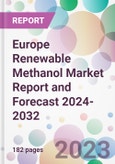Market Outlook
According to the report the Europe renewable methanol market grew significantly in 2023. Aided by the escalating concerns about environmental degradation and the pressing need for alternative, eco-friendly fuels, the market is projected to further grow at a CAGR of 31.7% between 2024 and 2032.Renewable methanol, often derived from sources like industrial waste, biomass, and carbon dioxide, is gaining traction as an alternative to conventional fuels and a solution for reducing greenhouse gas emissions. Being a versatile compound, it can be utilised as a fuel, an antifreeze in pipelines, and a feedstock for various chemical products.
As per the Europe renewable methanol market analysis, the growing emphasis on reducing carbon footprints has led European nations to look for sustainable alternatives to conventional energy sources. Renewable methanol, with its capability to produce lesser emissions compared to its fossil-based counterpart, has thereby emerged as a preferred choice in the region.
Furthermore, Europe's aggressive goals and policies supporting green initiatives have been crucial catalysts in the Europe renewable methanol market growth. The stringent regulations imposed on industries regarding emissions and the substantial incentives provided for the adoption of cleaner fuels have made renewable methanol an appealing proposition for various sectors.
An additional factor driving the market is the surge in research and development activities in the region. Companies are increasingly investing in technology that can efficiently produce renewable methanol from green hydrogen and captured carbon dioxide, providing a dual solution of energy production and carbon capture and further propelling the Europe renewable methanol market demand.
The transportation sector is seeing a considerable shift towards the adoption of renewable methanol. With the automotive industry focusing on innovations to reduce environmental impacts, renewable methanol is being eyed as a potential primary or additive fuel for vehicles.
Moreover, Europe's chemical industry, known for its robustness, is gradually transitioning to renewable methanol as a key ingredient in the production of formaldehyde, acetic acid, and other chemicals, further increasing the value of the Europe renewable methanol market size. This transition not only aligns with the region's green objectives but also ensures a stable supply of raw materials that are less susceptible to price volatility seen in fossil fuels.
Market Segmentation
The market can be divided based on feedstock, processing techniques, application, and country.Market Breakup by Feedstock
- Biomass
- CO2 and Hydrogen
Market Breakup by Processing Techniques
- Gasification
- Reformer-Based Production from Biogas
- Production During the Pulping Process
- Production from CO2 and Hydrogen
Market Breakup by Application
- Dimethyl Ether (DME)
- Methyl Tert-Butyl Ether (MTBE)
- Gasoline Blending
- Others
Market Breakup by Country
- United Kingdom
- Nordics
- Germany
- France
- Others
Competitive Landscape
The report looks into the market shares, plant turnarounds, capacities, investments, and mergers and acquisitions, among other major developments, of the leading companies operating in the Europe renewable methanol market. Some of the major players explored in the report are as follows:- Carbon Recycling International (CRI)
- Hy2gen AG
- OCI N.V.
- Södra Skogsägarna
- BASF SE
- New Fuel A/S
- Others
Table of Contents
Companies Mentioned
- Carbon Recycling International (CRI)
- Hy2gen AG
- OCI N.V.
- Södra Skogsägarna
- BASF SE
- New Fuel A/S
Methodology

LOADING...








